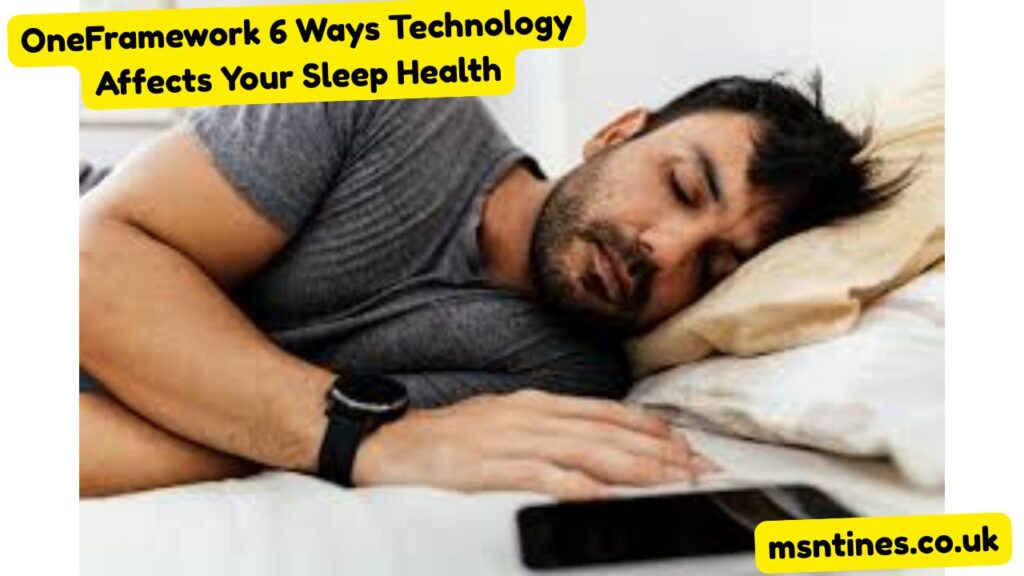In the digital age, technology is everywhere — from smartphones and tablets to televisions and wearable devices. While these tools offer undeniable benefits, they also influence our well-being in subtle yet significant ways. One notable area is sleep. This article explores the OneFramework 6 ways technology affects your sleep health, a structured approach to understanding the connection between digital habits and sleep quality.
1. Blue Light Disrupts Melatonin Production
The first point in the OneFramework 6 ways technology affects your sleep health involves blue light exposure. Most screens emit blue light, which interferes with the body’s natural circadian rhythm. This artificial light suppresses melatonin, the hormone responsible for making you feel sleepy. The result? Delayed sleep onset and reduced sleep quality.
2. Nighttime Notifications Interrupt Sleep Cycles
Even when you’re asleep, your phone isn’t. Constant notifications — messages, app alerts, reminders — can disrupt your REM cycle, causing micro-awakenings that you might not even remember. This is another core example in the OneFramework 6 ways technology affects your sleep health, showing how background tech activity can interfere with deep, restorative sleep.
3. Pre-Bed Screen Time Leads to Mental Overstimulation
Watching fast-paced videos, scrolling through social media, or playing video games before bed activates the brain. This kind of mental stimulation is a barrier to sleep, making it harder to relax and transition into a restful state. It’s a critical component in the OneFramework 6 ways technology affects your sleep health, as overstimulation directly impacts how quickly and deeply you fall asleep.
4. Increased Stress and Sleep Anxiety
Technology is a major driver of stress — news alerts, work emails, social comparison. When these digital stressors are part of your pre-bed routine, they raise cortisol levels, a hormone linked to wakefulness. This effect further compounds sleep difficulties, making it one of the more indirect but powerful entries in the OneFramework 6 ways technology affects your sleep health.
5. Disrupted Sleep Environments
Devices like TVs, tablets, or phones in the bedroom emit not only light but also sound and electromagnetic waves. Even small background noises or vibrations can pull you out of deep sleep. A cluttered sleep environment full of screens directly undermines sleep hygiene, adding another layer to the OneFramework 6 ways technology affects your sleep health model.
6. Sedentary Behavior and Daytime Fatigue
A sedentary lifestyle driven by technology use (working on a laptop, gaming, endless streaming) reduces physical activity. Lack of movement affects your ability to feel tired at night. In the OneFramework 6 ways technology affects your sleep health, this final factor highlights how poor physical habits rooted in tech reliance contribute to fragmented or insufficient sleep.
Tips for Managing Technology and Improving Sleep
Understanding the OneFramework 6 ways technology affects your sleep health helps you make better choices. Here are practical tips to offset the impact:
- Establish a no-screen rule 1 hour before bed
- Use blue light filters or “night shift” modes
- Silence or turn off notifications at night
- Keep devices out of the bedroom
- Practice a relaxing bedtime routine
- Engage in regular physical activity during the day
Final Thoughts
The OneFramework 6 ways technology affects your sleep health offers a clear structure to evaluate how digital habits interfere with your rest. From light exposure to behavioral patterns, technology plays a larger role in sleep health than many realize. By becoming aware of these six factors and making intentional changes, you can significantly improve both your sleep quality and overall well-being.
Also Read : Toji Honey House?? Everything You Need to Know About Toji Honey House and Why It Matters
